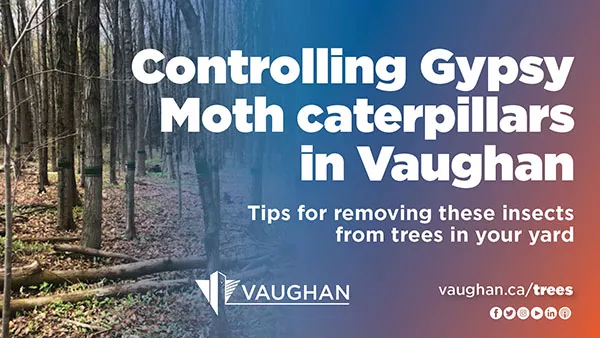Controlling Gypsy Moth caterpillars in Vaughan
Tips for removing these insects from trees in your yard
Gypsy Moths have made a home in Vaughan this summer, and you may be wondering how to control them. The City of Vaughan is here to provide simple tips for managing and removing Gypsy Moths from trees and shrubs on your property.
Gypsy Moths have made a home in Vaughan this summer, and you may be wondering how to control them. The City of Vaughan is here to provide simple tips for managing and removing Gypsy Moths from trees and shrubs on your property.
Gypsy Moths are between the caterpillar and pupa stage of their life cycle right now. Homeowners can take either of the following steps to protect their trees:
- Using gloves, pick caterpillars or pupae off leaves, tree trunks and branches and soak them in soapy water to destroy them. Alternatively, spray warm, soapy water on the trees and discard of the insects.
- Collect caterpillars by wrapping tree trunks in burlap or barrier bands and remove and destroy insects daily in soapy water. If using burlap, wrap it around the tree’s trunk, secure in the centre with a rope and fold the top half over the bottom to form a ring. The insects will move under the burlap, making it easy for you to remove and discard them.
- Spray BTK – an organic insecticide that can be effective when applied to caterpillars. It is non-toxic to animals, humans, plants and most other insects and is available at most hardware stores and nurseries.
What the City does to control Gypsy Moths on public property
To help control the Gypsy Moth population, the City began city-wide treatment in May in heavily infested areas. The City has placed barrier bands on more than 600 trees with a target of 1,000 and has removed approximately 2,000 egg masses from over 500 public trees. To receive up-to-date information on the City’s continued efforts to control the Gypsy Moth population, keep checking back at vaughan.ca/trees.
Gypsy Moths are an invasive species that eat leaves from hardwood trees such as oak, maple, birch and aspen, and select shrubs. From early May to mid-July, the caterpillars are hatching and will eat leaves and feed for approximately seven weeks. Affected trees will usually grow a second crop of leaves in the same season.
For more information, visit the Ministry of Agriculture, Food and Rural Affair’s webpage. If you have concerns about trees on your property, contact an arborist. For materials and supplies, contact your local nursery or garden supply store.
To receive the City’s latest updates as they happen, sign up for the City Update eNewsletter at vaughan.ca/CityUpdate and follow the City’s Twitter, Facebook, Instagram and LinkedIn channels.
-30-

